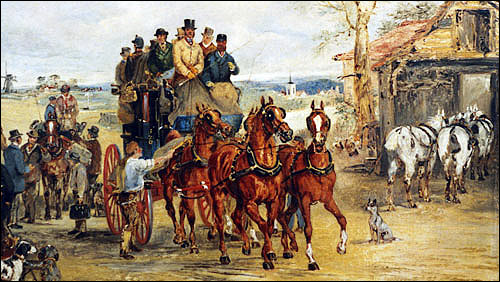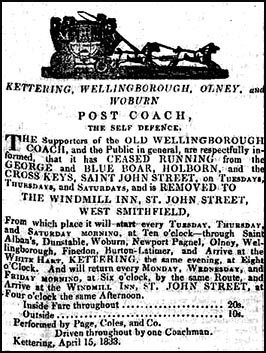|
|||
|
|||
|
Thanks to Victorian-style illustrations on Christmas cards and tins of Quality Street, mail coaches have acquired a certain cherished position in the national culture: the tall hats, the post horn, the team of horses, etc. Although they are and were seen as having a certain dash, and were indeed an effective way of travelling around the country in a reasonable time, the reality was that the ride could be hard, bouncy and uncomfortable, and unpleasant in times of heavy rain. Henry VIII created the office of 'Master of the Posts' in the early 1500s. The responsibility was to ensure the delivery of the king’s despatches (the 'royal mail') throughout the country. Even before that time, horses had of course been used to for the delivery of those despatches. The new system was for riders travelling in relay between 'Posts', or stages - each one being about twenty miles apart, since that was the furthest a horse was generally reckoned to be able to travel at a constant comfortable speed before it tired and had to be replaced. By the late 18th century, a new system was introduced whereby mail was delivered by horse-drawn coach, with swift changes of horses every 10 miles. This allowed a high average speed and increased security for the mail. The first regular mail coach route was established from Bristol to London, via Bath, in 1784. By the end of 1785, coaches were travelling the length and breadth of England. For the next fifty years, mail coaches were the speediest road service in the country. Originally for mail only, with only Post Office employees on board, they gradually became a passenger service too. The Red Cow Inn in the High Street was the usual stop for mail coaches. Although it advertised "Good Stabling", it was only a stop. It was not a staging post and horses were not changed there, and the stables were more likely to be used by people travelling to and from outlying areas who were leaving or joining the mail coach, and wanted their horses tended while they were away. The Dukes Arms and the Waggon and Horses also had stabling facilities, but Burton Latimer in general was the stop south of Kettering for the mail coaches which came through on their way to and from London. We know one route was Leeds to London, because there is a report of a robbery of a mail coach in 1812, not long after it left Burton.
By the time of the arrival of the railway in Burton in the 1850s, the age of the mail coach was already over - the very last London-based mail coach had left for Norwich in April 1846. If anyone has any further information about mail coaches in Burton, we would be only to happy to expand this page.
|
|||

